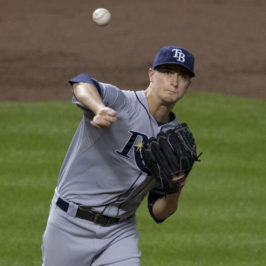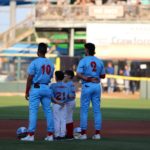
Since the 2016 World Series ended, there has been a lot of talk about the way both teams used some of their pitchers. Some pundits have wondered if this is going to usher in a new approach to how pitchers are used and others insist that there is a huge difference between what can be done in a short series and what is possible over the length of a full season.
We have so much data now. We are rethinking what we thought we knew about the game in many ways. Some people, both inside the game and out, insist that all of our decisions need to be data driven while others feel that the old ways are still the best. Still others are trying to straddle the fence and take pieces of each era to try to create what they hope will be the right approach.
Regardless of where you might stand personally in this debate, it is clear that the debate is here to stay and that baseball teams are going to continue to try to figure out ways to gain some kind of advantage over the rest of the league.
It seems that one of those ways that is going to come to pass (and likely sooner rather than later as a result of what we saw in the last postseason) is that one way to gain an advantage might be in how pitching staffs are constructed and how pitchers are subsequently deployed.
This is not a new idea in any way. It goes back as far as Bill James’ website. And there have been articles in the recent past at both Fangraphs and Baseball Prospectus. Each of these articles comes at the idea from a slightly different perspective, but the general idea is essentially that teams can benefit from rethinking the synergies to be gained by new ideas about the uses of starting and relief pitchers.
We can start with the idea that a fair number of major league teams don’t have a true number one starter. Some teams might have trouble realistically convincing us that they even have a number two. Add to that the fact that numbers tell us that pitchers are generally less effective the longer they go in a game.
That combination of facts opens up lots of possibilities in how to set up and use a pitching staff. In addition to the three different approaches noted above, there are numerous variations on the theme. My own thoughts in this direction began several years ago when there were a few teams that were talking about the idea of trying to limit the innings that some younger pitchers or those recovering from injury would throw while still having them available later in the season. The Nationals famously failed this test with Stephen Strasburg awhile back. I felt it might make sense to simply commit to using (at least) 6 starters from Day 1.
To illustrate this kind of approach, let’s use the 2017 Rays. They have two guys who it seems would be ‘normal’ starters who they would want to start every fifth day in Archer and Odorizzi. They would get 35 or so starts each. Then they have Blake Snell, who has never thrown as many as 155 innings in a season and Alex Cobb, coming off elbow surgery. Putting them on an every sixth day schedule would limit their starts and give them each about 25. Then they have Matt Andriese, who is serviceable but not special and Jose de Leon, another good young arm who has never pitched even 120 innings in a season. They would each fill in the gaps and get about 20 starts each. The Rays also have Chase Whitley (also coming off an arm injury) and Jamie Shultz, Jacob Faria and Brett Honeywell close to ready so that when an injury hits, they can continue the theory pretty flawlessly. While you can’t plan an entire season at once, it is certainly possible to plan two to three weeks ahead and keep something like this going.
The second part of this type of plan is to assemble a bullpen that has some flexibility. A good mix of left and right handers who can be trusted to throw as many as 25-35 pitches every other day would be ideal. Whitley, Alex Colome, Xavier Cedeno, Brad Boxberger and Erasmo Ramirez would be a great group, though replacing one of the righties with a lefty would be better.
This would put the team in a position to throw their better starters in typical fashion at maybe 100 pitches per outing, leaving another pitcher or two to go the remaining 50-60 pitches of a typical game. The lesser pitchers could be limited in their exposure to a lineup at maybe 60 pitches, leaving three pitchers to pick up the remaining 100ish. Proper planning would keep everyone fresh and maximize the potential for success.
Every team in the major leagues could benefit from some kind of pitching approach like the ones described here.
So what are the pros and cons to giving a new idea a try?
PROS
- Teams could likely get by with one fewer pitcher on the 25 man roster, leaving another spot for an offensive reserve.
- Limiting the appearances/pitches for less effective pitchers is an obvious boost to the team.
- Planning to use relievers longer can lead to fewer pitching changes, which we have heard are bad.
- A properly constructed staff could possibly take advantage of the explosion of platoons in the game currently. A starter going through the order twice then two relievers going through it once each could be deployed to change hitters’ handedness more effectively than by trying to do it one batter at a time.
CONS
- Perhaps the biggest problem here is the fact that it’s currently unorthodox. Getting buy-in at the various levels of a team may be tough. It would be especially tough when one pitcher pitches well and is taken out for another who has a bad game. Fan pushback will not be pretty.
- Players will likely rebel, especially those starters not allowed to go five innings. Let’s not even think about what their agents might say. The proliferation of numbers recently is often geared toward individual value. We sometimes forget that having your team win is the ultimate goal.
- Along those same lines, many pitchers feel they are more effective when they have consistent, defined roles. This kind of plan would be less consistent and defined, but more fluid.An idea like this would take careful planning. You would think that plans should be a part of what teams do anyway, but if they were teams would not consistently be caught midseason with the ‘problem’ of how to limit innings
The Future
The Rockies have already done some limited unconventional things with pitching in the past. They currently are well suited to try something different as they have a number of questions in the rotation. They also have five relievers who have been closers at one point or another. With Bud Black as their manager, we should be watching them closely as their pitching philosophy shakes itself out.
Tony LaRussa also experimented a bit with the 3-3-3 idea for about a week in the 90s when he managed in Oakland. There is certainly precedent for some of these ideas.
With the quest for an edge so strong in MLB, it seems that some sort of outside the box pitching approach will be seen soon. As fantasy players, it is important for us to try to be ahead of the curve in how we assemble our own teams. As we look at pitching prospects, we might want to look at guys who can be more versatile if they are not future number ones. We also need to be thinking ahead to be ready to tweak our rosters and scoring systems as the changes come.
I live at the beach in Palm Coast, FL with my wife. I'm an old retired guy whose main job is hosting trivia shows at golf courses for which I get free golf at several upscale golf courses. When it rains and I can't play golf, I read about baseball and try to find the next underrated prospect.





Leave a Reply